Functions of an Ecosystem- 1 | Environment for UPSC CSE PDF Download
| Table of contents |

|
| What Are the Functions of Ecosystem? |

|
| What is a Food Chain? |

|
| What is a Food Web? |

|
| What are the Ecological Pyramids? |

|
| Pollutants and Trophic Level |

|
What Are the Functions of Ecosystem?
The function of an ecosystem is a broad, vast and complete dynamic system. Which are:
- Energy flow
- Nutrient cycling (biogeochemical cycles)
- Ecological succession or ecosystem development
Energy Flow
- Energy is the primary force responsible for all metabolic activities. The flow of energy from producer to top consumers is called unidirectional energy flow.
- The study of Trophic level interaction in an ecosystem gives an idea about the ecosystems energy flow.
Trophic level interaction
- Trophic level interaction deals with how the members of an ecosystem are connected based on nutritional needs.
- Energy flows through the trophic levels: from producers to subsequent trophic levels. This energy always flows from lower (producer) to higher (herbivore, carnivore etc.) trophic. It never flows in the reverse direction that is from carnivores to herbivores to producers.
- There is a loss of some energy in the form of unusable heat at each trophic level so that energy level decreases from the first trophic level upwards. As a result, there are usually four or five trophic levels, and seldom more than six as beyond that very little energy is left to support any organism. Trophic levels are numbered according to the steps an organism is away from the source of food or energy, that is the producer.
The trophic level interaction involves three Components
- Food Chain
- Food Web
- Ecological Pyramids
What is a Food Chain?
Organisms in the ecosystem are related to each other through feeding mechanism or trophic levels, i.e. one organism becomes food for the other. A sequence of organisms that feed on one another, form a food chain. A food chain starts with producers and ends with top carnivores.
Types of Food Chains
In nature, two main types of food chains have been distinguished:
(i) Grazing food chain: The consumers who start the food chain, utilizing the plant or plant part as their food, constitute the grazing food chain. This food chain begins from green plants at the base, and the primary consumer is a herbivore.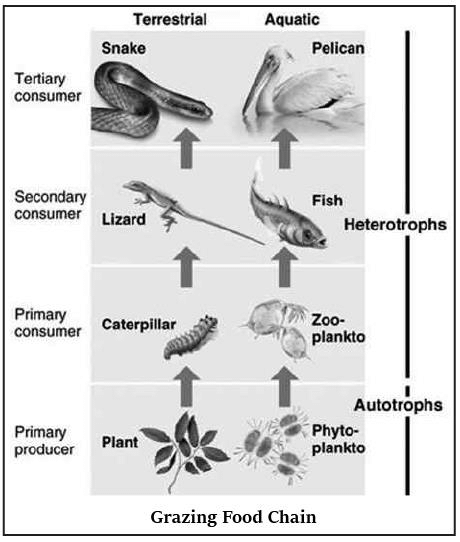
- For example, the grass is eaten up by caterpillars in the terrestrial ecosystem, which is eaten by lizards and lizards are consumed by the snake.
- In the Aquatic ecosystem, phytoplankton (primary producers) are eaten by zooplanktons eaten by fishes and fishes are eaten by pelicans.
(ii) Detritus food chain: It starts from dead organic matter of decaying animals and plant bodies consumed by the micro-organisms and then to detritus feeding organisms called detritivores or decomposer and to other predators.
- The distinction between these two food chains is the source of energy for the first level consumers.
- In the grazing food chain, the primary energy source is living plant biomass while in the detritus food chain, the source of energy is dead organic matter or detritus. The two food chains are linked. The detritus food chain's initial energy source is the waste materials and dead organic matter from the grazing food chain.
What is a Food Web?
- A food chain represents only one part of the food or energy flow through an ecosystem and implies a simple, isolated relationship, which seldom occurs in ecosystems. An ecosystem may consist of several interrelated food chains.
- The same food resource is more typically part of more than one chain, especially when that resource is at the lower trophic levels." "A food web illustrates all possible transfers of energy and nutrients among the organisms in an ecosystem, whereas a food chain traces only one pathway of the food".
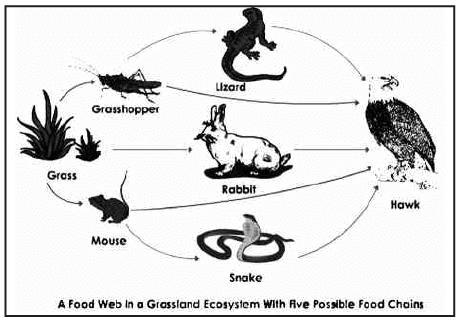
- If any of the intermediate food chains are removed, the chain's succeeding links will be mainly affected. The food web provides more than one alternative for food to most of the organisms in an ecosystem, increasing their chance of survival.
For example, grasses may serve food for rabbits or grasshoppers or goats or cows. Similarly, a herbivore may be a food source for many carnivorous species.
Also, food availability and food preferences may shift seasonally, e.g. we eat watermelon in summer and peaches in the winter. Thus there are interconnected networks of feeding relationships that take the form of food webs.
What are the Ecological Pyramids?
- The steps of trophic levels expressed in a diagrammatic way are referred to as ecological pyramids. The food producer forms the base of the pyramid, and the top carnivore includes the tip.
- Other consumer trophic levels are in between. The pyramid consists of several horizontal bars depicting specific trophic levels arranged sequentially from primary producer level through herbivore, carnivore onwards. The length of each bar represents the total number of individuals at each trophic level in an ecosystem.
The number, biomass and energy of organisms gradually decrease with each step from the producer level to the consumer level, and the diagrammatic representation assumes a pyramid shape.
➤ The ecological pyramids are of three categories.
- Pyramid of numbers,
- Pyramid of biomass, and
- Pyramid of energy or productivity.
Pyramid of Numbers
This deals with the relationship between the numbers of primary producers and consumers of different levels. It is a graphic representation of the total number of individuals of different species, belonging to each trophic level in an ecosystem. Depending upon the size and biomass, the pyramid of numbers may not always be upright, and may even be completely inverted.
(i) Pyramid of numbers - upright
- In this pyramid, the number of individuals is decreased from lower level to higher trophic level.
- We can see this type of pyramid in a grassland ecosystem.

- The grasses occupy the lowest trophic level (base) because of their abundance.
- The next higher trophic level is a primary consumer - herbivore (example – grasshopper).
- The individual number of the grasshopper is less than that of grass. The next energy level is a primary carnivore (example – rat).
- The number of rats is less than a grasshopper because they feed on a grasshopper. The next higher trophic level is a secondary carnivore (example – snakes). They feed on rats.
- The next higher trophic level is the top carnivore. (Ex. Hawk).
- With each higher trophic level, the number of individuals decreases.
(ii) Pyramid of numbers - inverted
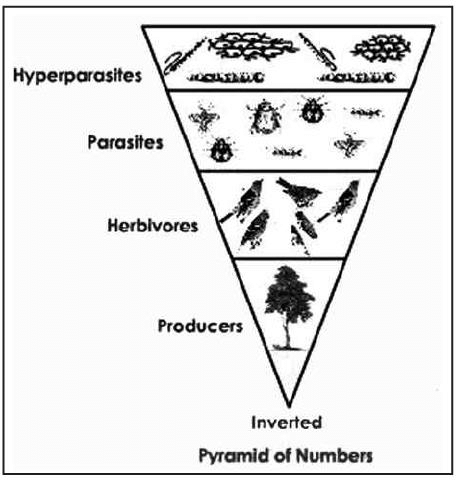
- In this pyramid, the number of individuals is increased from lower level to higher trophic level.
- A count in a forest would have a small number of large producers, e.g. a few big trees.
- This is because the tree (primary producer) is few in number and would represent the pyramid's base. The dependent herbivores (Example - Birds) in the next higher trophic level and parasites follow it in the next trophic level. Hyper parasites being at a higher trophic level, represents higher in number.
- And the resulting pyramid is in inverted shape. A pyramid of numbers does not consider the fact that the size of organisms being counted in each trophic level can vary.
- It is complicated to count all the organisms in a pyramid of numbers and so the pyramid of number does not wholly define the trophic structure for an ecosystem.
 |
Download the notes
Functions of an Ecosystem- 1
|
Download as PDF |
Pyramid of Biomass
- To overcome the shortcomings of the pyramid of numbers, the pyramid of biomass is used. In this approach, individuals in each trophic level are weighed instead of being counted.
- This gives us a pyramid of biomass, i.e., the total dry weight of all organisms at each trophic level at a particular time.
- Pyramid of biomass is usually determined by collecting all organisms occupying each trophic level separately and measuring their dry weight. This overcomes the size difference problem because all kinds of organisms at a trophic level are weighed. Biomass is measured in g/m2.
(i) Upward pyramid
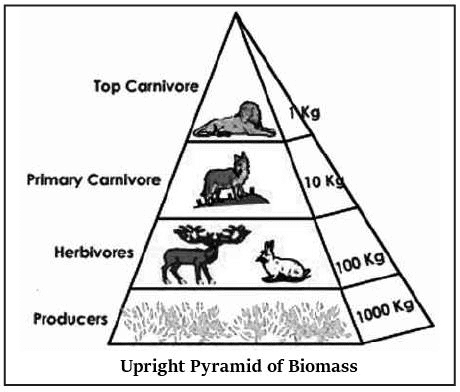
- For most ecosystems on land, the pyramid of biomass has a large base of primary producers with a smaller trophic level perched.
- The biomass of producers (autotrophs) is at the maximum. The biomass of next trophic level, i.e. primary consumers is less than the producers. The biomass of the next higher trophic level, i.e. secondary consumers is less than the primary consumers. The top, high trophic level has very less amount of biomass.
(ii) Inverted pyramid
- In contrast, in many aquatic ecosystems, the pyramid of biomass may assume an inverted form. This is because the producers are tiny phytoplankton that grows and reproduces rapidly.

- Here, the biomass pyramid has a small base, with the consumer biomass at any instant actually exceeding the producer biomass, and the pyramid assumes an inverted shape.
Pyramid of Energy
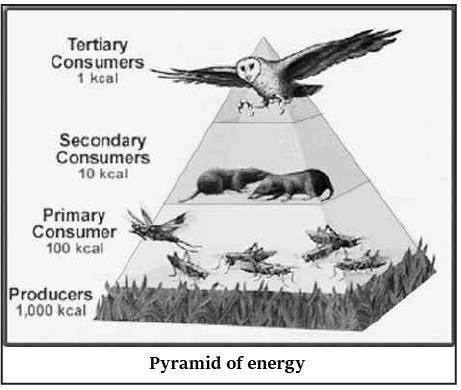
- To compare the trophic levels' functional roles in an ecosystem, an energy pyramid is most suitable. An energy pyramid reflects the laws of thermodynamics, with the conversion of solar energy to chemical energy and heat energy at each trophic level and with loss of energy being depicted at each transfer to another trophic level. Hence the pyramid is always upward, with a large energy base at the bottom.
- Suppose an ecosystem receives 1000 calories of light energy in a given day. Most of the energy is not absorbed; some is reflected space; of the power absorbed only a small portion is
Pollutants and Trophic Level
- Pollutants, especially nondegradable ones, move through the various trophic levels in an ecosystem. Nondegradable pollutants mean materials, which cannot be metabolized by the living organisms.
Example: chlorinated hydrocarbons. - We are concerned about these phenomena because together they enable even small concentrations of chemicals in the environment to find their way into organisms in high enough doses to cause problems.
Movement of these pollutants involves two main processes
(i) Bioaccumulation
- It refers to how pollutants enter a food chain.
- In bioaccumulation, there is an increase in the concentration of a pollutant from the environment to the first organism in a food chain.
(ii) Biomagnification

- Biomagnification refers to pollutants' tendency to concentrate as they move from one trophic level to the next.
- Thus in biomagnification, there is an increase in a pollutant's concentration from one link in a food chain to another.
- For biomagnification to occur, the pollutant must be long-lived, mobile, soluble in fats, biologically active. If a contaminant is short-lived, it will be broken down before it can become dangerous. If it is not mobile, it will stay in one place and is unlikely to be taken up by organisms. If the pollutant is soluble in water, it will be excreted by the organism.
- Pollutants that dissolve in fats, however, may be retained for a long time. It is traditional to measure the number of contaminants in fatty tissues of organisms such as fish. In mammals, we often test the milk produced by females, since the milk has a lot of fat in it and is often more susceptible to damage from toxins (poisons).
- If a pollutant is not active biologically, it may biomagnify, but we really don't worry about it much, since it probably won't cause any problems.
Examples: DDT.
|
96 videos|190 docs|52 tests
|
FAQs on Functions of an Ecosystem- 1 - Environment for UPSC CSE
| 1. What are the functions of an ecosystem? |  |
| 2. What is a food chain? |  |
| 3. What is a food web? |  |
| 4. What are ecological pyramids? |  |
| 5. How do pollutants affect trophic levels in an ecosystem? |  |

































